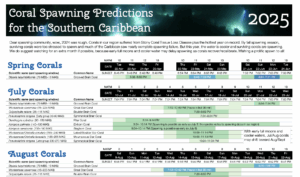CARMABI’s 2025 coral spawning predictions for the southern Caribbean
We are pleased to share this year’s coral spawning predictions. Based on last year’s surveys (and those from the 30+ years before that), we have come up with predictions for the dates and times when many Caribbean coral species will produce the next generation of corals.
Note that these predictions are only applicable to the Southern Caribbean and that spawning events of some species remain difficult to predict.
Please take our short survey (if you haven’t already): We are striving to improve the information provided through these annual predictions and are curious what suggestions or questions you might have. You can also sign up for newsletters and receive updates when future calendars are released. Help us measure our reach with our short survey here.
Introductory note for this year’s prediction: Dear spawning community, 2024 was rough. Corals in our region suffered from Stony Coral Tissue Loss Disease plus the hottest year on record. By fall spawning season, surviving corals were too stressed to spawn and much of the Caribbean saw nearly complete spawning failure. But this year, the water is cooler and surviving corals are spawning. We do suggest diving an extra month if possible (i.e., also the month following the current predicted windows) because full moons occur relatively early each month and cooler water may delay spawning as corals recover/recalibrate. Wishing everyone a prolific spawn!

You can download the 2025 spawning predictions through the following link:
 Tips for those that want to observe coral spawning
Tips for those that want to observe coral spawning
- Spawning is never guaranteed, especially in a changing climate. When in doubt, go for a dive.
- Predictions do not include buffers; we suggest entering the water well before predicted times.
- Dive in a place with high coral cover.
- Make multiple dives on multiple nights.
- Dive shallower than 50′ to maximize dive time.
- Use a moderately bright dive light.
- Scan the water column for clouds of spawn and trace them back to the colony that released them.
- Spawn from most brain/star/elkhorn/staghorn corals looks like snow/confetti/polka dots.
- Spawn from starlet, pillar, maze, and pineapple corals and male great star corals looks like puffs of smoke or sprays of fine sand.
- Spawn from female great star corals looks like chunky vomit (hooray!).
- Spawning depends on local sunset times; to adjust dives based on your local sunset times.
Coral Breeding Reference Sheets: This new community resource for coral propagation, led by Val Chamberland, is now available to download here for the following species:
Acropora palmata
Orbicella faveolata
Diploria labyrinthiformis
Porites porites
Please share your observations: Your discoveries help coral research and conservation! A new AGGRA database is under development to collect and distribute regional spawning data. Therefore, if you monitor spawning, please record as many of the following details as possible: Date, location, site name (or lat/long), depth, species, setting time (if seen), spawning start and stop times, area monitored in m2, # of colonies monitored, % of colonies that spawned, # of male/female colonies (if applicable). Photos, partial records, and records of no spawn are all very welcome! Send reports to carmabilog@gmail.com, v.chamberland@secore.org, or kristen@marhaverlab.com. You can also post your observations at https://www.facebook.com/groups/CoralSpawningResearch.
Huge thanks to everyone who shared observations over the past 30+ years. The Curacao team wishes you a safe and productive spawning season!